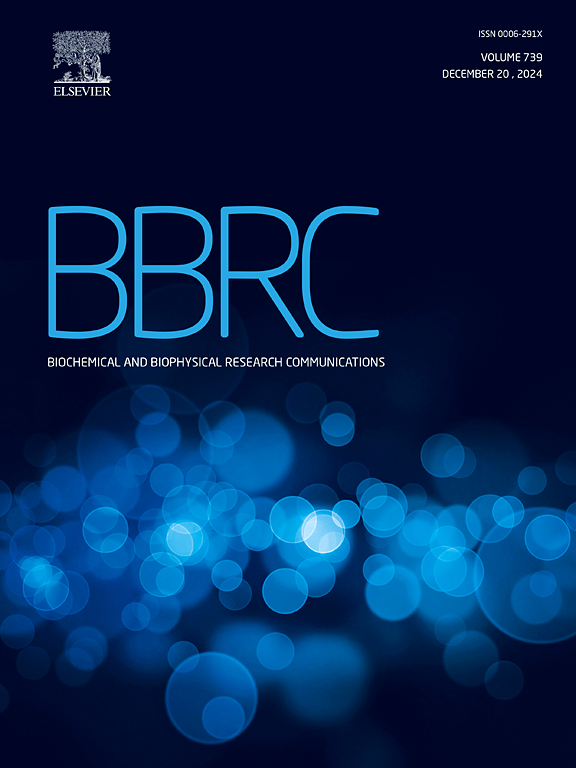鸟氨酸脱羧酶1调节糖毒性和脂毒性应激下质膜完整性和相关基因网络:一项体外研究。
IF 2.2
3区 生物学
Q3 BIOCHEMISTRY & MOLECULAR BIOLOGY
Biochemical and biophysical research communications
Pub Date : 2025-10-14
DOI:10.1016/j.bbrc.2025.152807
引用次数: 0
摘要
高血糖标志着2型糖尿病的发病,其发病机制涉及糖毒性和脂肪毒性,损害胰腺β细胞功能和质膜完整性。虽然质膜破坏被认为是糖尿病并发症的关键因素,但代谢应激下保护膜结构的分子机制仍然知之甚少。尽管鸟氨酸脱羧酶1 (ODC1)被认为是多胺生物合成的关键酶,在细胞生长和应激反应中发挥作用,但其在糖毒性和脂毒性条件下对质膜保护的具体贡献尚未得到系统的研究。尽管它在胰腺中反应最灵敏且表达最多,但缺乏对其作用的了解限制了我们对可作为糖尿病治疗靶点的膜保护机制的理解。为了解决这一空白,我们研究了代谢应激条件下ODC1调节如何影响质膜结构和相关基因表达网络。来自GEO数据库的人胰岛数据集的差异基因表达分析鉴定出2型糖尿病中与ODC1共表达的质膜相关基因。我们利用HEK293T细胞建立体外糖毒性和脂毒性模型,并通过过表达和小干扰(siRNA)介导的敲低来调控ODC1的表达。基因表达验证显示,ODC1可调控JUN、RHOA、CAV1、PRNP、SGK1、ATP5B、CLIC4和CCND1等质膜基因,而ODC1敲低可损害细胞膜损伤和细胞凋亡特征。这些发现证实了ODC1是代谢应激期间维持质膜结构的关键保护因子,揭示了保护2型糖尿病β细胞功能的新治疗靶点。本文章由计算机程序翻译,如有差异,请以英文原文为准。
Ornithine decarboxylase 1 modulation regulates plasma membrane integrity and associated gene networks under glucotoxicity and lipotoxicity stress: An in vitro study
Hyperglycemia marks the onset of type 2 diabetes, and its pathogenesis involves glucotoxicity and lipotoxicity that compromise pancreatic β-cell function and plasma membrane integrity. While plasma membrane disruption is recognized as a critical factor in diabetic complications, the molecular mechanisms protecting membrane structure under metabolic stress remain poorly understood. Despite ornithine decarboxylase 1 (ODC1) being identified as a key enzyme in polyamine biosynthesis with roles in cellular growth and stress response, its specific contribution to plasma membrane protection during glucotoxicity and lipotoxicity conditions has not been systematically investigated. Despite being the most responsive and abundantly expressed in the pancreas, the lack of insight into its role restricts our understanding of membrane-protective mechanisms that could serve as therapeutic targets for diabetes management. To address this gap, we examined how ODC1 modulation affects plasma membrane structure and associated gene expression networks under metabolic stress conditions. Differential gene expression analysis of human pancreatic islet datasets from the GEO database identified plasma membrane-associated genes co-expressed with ODC1 in type 2 diabetes. Using HEK293T cells, we established in vitro models of glucotoxicity and lipotoxicity and manipulated ODC1 expression through overexpression and small interfering (siRNA)-mediated knockdown. Gene expression validation revealed that ODC1 regulates plasma membrane genes, including JUN, RHOA, CAV1, PRNP, SGK1, ATP5B, CLIC4, and CCND1, while ODC1 knockdown impaired membrane damage and apoptotic features. These findings establish ODC1 as a critical protective factor maintaining plasma membrane structure during metabolic stress, revealing novel therapeutic targets for preserving β-cell function in type 2 diabetes.
求助全文
通过发布文献求助,成功后即可免费获取论文全文。
去求助
来源期刊
CiteScore
6.10
自引率
0.00%
发文量
1400
审稿时长
14 days
期刊介绍:
Biochemical and Biophysical Research Communications is the premier international journal devoted to the very rapid dissemination of timely and significant experimental results in diverse fields of biological research. The development of the "Breakthroughs and Views" section brings the minireview format to the journal, and issues often contain collections of special interest manuscripts. BBRC is published weekly (52 issues/year).Research Areas now include: Biochemistry; biophysics; cell biology; developmental biology; immunology
; molecular biology; neurobiology; plant biology and proteomics

 求助内容:
求助内容: 应助结果提醒方式:
应助结果提醒方式:


